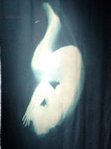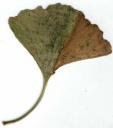Antarctic Insights
The circle, the spiral and the cross are combined to identify physical structures within the Antarctic environment: bottom water circulation, the circumpolar current and the one solid pivot point of the earth's rotation. To some people these forms represent the telescopic cross hairs in a rifle and the spiraling thread within a rifle's barrel. They can therefore stir feelings of death and destruction. To other people these same forms stir feelings of unity, wholeness and new growth.
For me the iconography identifies humanity as at once a part of, and estranged from, the living world.

COMMENTS
Your COMMENTS are welcome. Contact me to send them. Comments help me understand what works (and what doesn't) to connect people to Antarctica.
Love your animation. Good way to get the idea of reducing carbon emissions through our sometimes "thick skulls". And a good fit too.
AAD librarian Graeme Watt, October 26th, 2009 at 11:52 am
Loved the idea of putting the Antarctic 'tadpole' as a brain inside the head. Then animating the 350, representing a realisable goal of 350 parts per million of carbon dioxide (we're currently sitting at 385 I think). Setting goals in terms of measurable quantities makes for a better focus for action.
Mind you, that being said, I am very pessimistic that there’ll be sufficient action to achieve that globally before we reach a catastrophic tipping point and by then the world will have erupted into "resource wars". I look at my grand kids with some sadness, as that point will almost certainly come within their lifetime.
ANARE veteran Bill Burch, October 26th, 2009 at 1:18 pm
Your graphic is great, but is the ice really melting in Antarctica? Rupert Murdoch's media say no, others say yes.
http://www.news.com.au/story/0,27574,25348657-401,00.html
http://www.theage.com.au/environment/antarctic-ice-melting-faster-than-expected-20090405-9t9v.html
Who knows?
ANARE veteran Owen Holmwood, October 26th, 2009 at 3:21 pm
I loved the animation as well. Very elegant and simple but conveying SOOOO much. I think Antarctica as brain is a master/mistress(?) stroke so much better than the body analogy.
Just one suggestion on the text. For me it is too academic. Why not use the animated text type of 350 to say "Antarctica is melting" to give it a more personal feeling and embody it in the figure???
New media artist Peter Charuk, October 27th, 2009 at 10:02 am
I had the same idea, of animating the words, 'Antarctica is melting', but resisted. I wanted the type-written text to appeal more to the mind than the body. I wanted to do this to balance the visceral connection evoked through the thicker hand-drawn lines at the start.
I believe that images of the whole body and the brain can work together. The body appeals to sensory awareness and the brain intellectual understanding.
Another thing that could be done is to add the sound of a pencil drawing the first thick lines. I will look again at this...
Simple, elegant and says it all...I support your passion to visually educate us all on the important issues of global warming
Melissa Smith, October 27th, 2009 at 6:38 pm
Thanks for your comment, Melissa. Global warming is a very complex issue! My passion is to reflect thoughts and feelings that people have shared with me about Antarctica, and, through animating, and writing about that process, to clarify my own! Although it may appear very simple, this last animation was the most challenging to make, stirring depths of feeling I did not anticipate.
Iconography combined:

Philippe Boissonnet, En perdre le nord, Photograph, 2008

Lorraine Beaulieu, Drapeau, Cyanotype. 2008

Rena Czaplinska, Gesture traced and animated. 2008

Kim Holten, Connectivity, Pencil on paper. 2008

Lisa Roberts, Trace Form of car journey through the Salisbury Plains, UK, 2008

Stephen Eastaugh, Finding Yourself Lost, Drawing. 2008


Lisa Roberts, An Ancient Mariner holds the world in balance, Drawings. 2009

Veins of the Ginko leaf radiating from a central point








